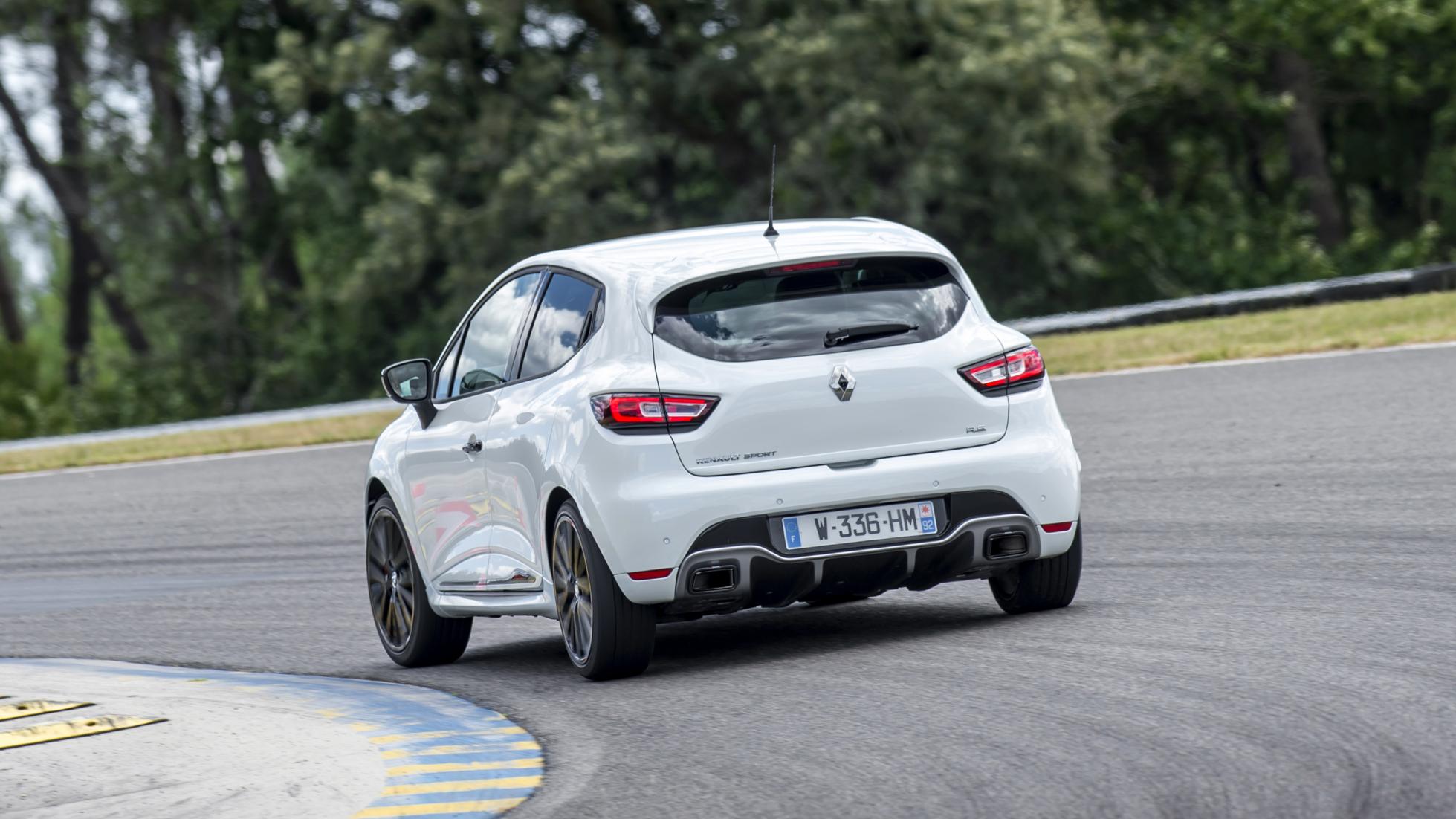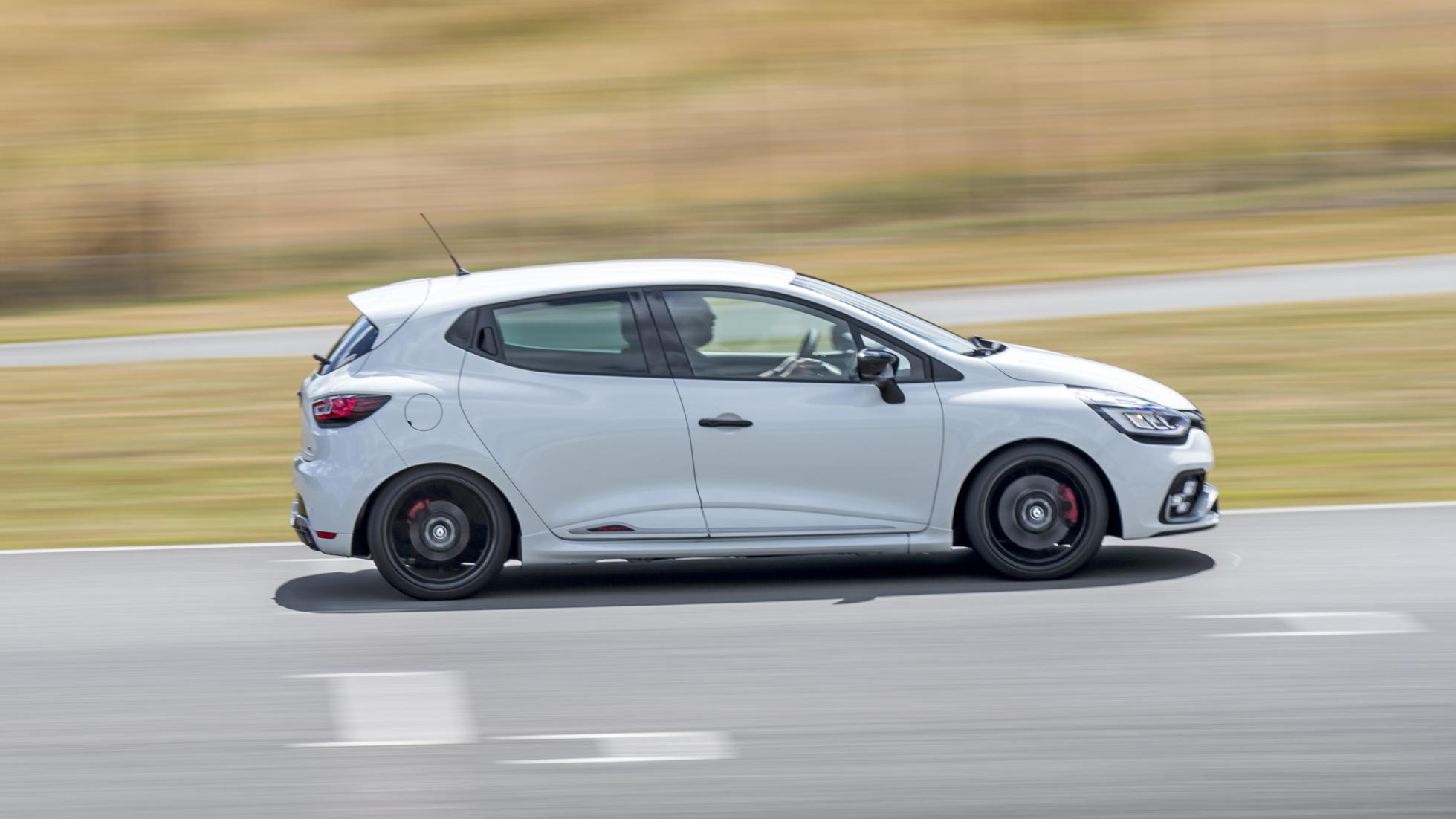
Long name. What’s a Renault Sport Clio 220 Trophy EDC?
Only the ‘Trophy’ bit is important. The Renault Sport Clio EDC (for Efficient Dual-Clutch) has been around since 2012, but here we’re talking about the facelifted version, and in its ultimate trim – the Trophy. That means 217bhp instead of 197bhp, a stiffer, lower chassis compared to regular Sport and Cup models, and a set of multispoke 18-inch wheels, which it has to be said, look pretty ace.
We’ll get onto the merits (or demerits) of a paddleshift in a moment. There’s no doubt its launch control and 150ms shifts light up the timing sheets though – the Trophy will get you from 0-62mph in 6.6 seconds, and to a top speed of 146mph. In a Clio. Which is a bit bonkers.
You've driven a ‘new’ Trophy once before, yes?
Yup, but exclusively on a circuit, and predictably, in daylight. That meant Stephen, who had first crack at the fastest Clio so far back in July, was denied a complete test of that stiffer ride, and just how powerful those new chequered-flag motif lights are…
Eh? The lights?
Yes, those funny looking blobs in the extremes of the lower grille, that make the Trophy look like a puppy baring its molars. Combined with new, far classier looking LED headlights, Renault claims a 40 per cent boost in illumination over the old Clio RS.
So, in the interests of seeing if this is the new after-dark hot hatch of choice, we waited for the sun to sink below the horizon, then took the Trophy to the countryside, where there are many badly surfaced roads and well, it’s so dark you can’t see your hand in front of your face.
Any good?
The lights? Exceedingly. The beam is white, bright and very, very powerful. I could name a few cars from premium stables which can pretty much outrun their headlights’ gaze at night, but the Clio could ward lost ships away from rocky outcrops if you live near the coast.
Top Gear
Newsletter
Thank you for subscribing to our newsletter. Look out for your regular round-up of news, reviews and offers in your inbox.
Get all the latest news, reviews and exclusives, direct to your inbox.
I meant the chassis, actually.
Ah. Well that’s a bit less, erm, clear. See, the current Clio RS, as you probably know, was a bit of a perfect storm for Renault. It followed one of the greatest hot hatches ever made, ditching a three-door widebody suit for a (admittedly handsome) five-door, binning natural aspiration for a turbo (to be fair, forced induction was needed to match power with economy) and worst of all, denying a manual gearbox. Dual-clutch with smooth, metal paddles annoyingly fixed to the steering column, or nowt.
As a result, it’s been rightly overshadowed by the fizzier, happier likes of the Fiesta ST and Peugeot Sport 208 GTi. The only area in which the Renault really held its own was chassis and damping, thanks to rally-style hydraulic bump stops that basically allow more of the damping stroke to be used to absorb bumps, before the car itself starts hopping around getting deflected. The Clio’s always been the easier car to carry big speed in.
Is the Trophy?
No. Resting 20mm lower at the front, 10mm lower at the rear and running stiffer rear springs plus beefier shock absorber rates, the result is a very busy ride. It’s largely well controlled and sure, it will pick up an inside rear for fun, which we’ll never tire of.
But unless you’re going to paste your Trophy at a track (as many Renaultsport fans do) regularly, this might just feel too uncompromising for your average hot hatch fan. It’s no longer holding the Compliant Ride ace Renault used to wield over the Fiesta ST.
Now, if we were talking about a stripped-out, two-seat Cliosport with say, a manual gearbox and 275bhp, then it’d feel more appropriate. Come on Renault, make the RS16. Please.
How’s the rest of the Trophy?
A mixed bag. Conventional bucket chairs instead of trademark Recaros continue to look disappointingly nondescript when you clamber in, but they’re comfortable, supportive, far better located in the car than the Fiesta’s bar stools and just as potently heated.
The steering’s still a weak point, lacking weight and crucial feedback, but torque-steer has been carefully tuned out and despite no front diff, the traction, even in damp and tricky conditions, is spectacular. In fact the whole car majors on massive grip, but the stiffer rear means it’s game for a laugh if you’re prepared to do yobbish provoke-y things mid-roundabout.
Mind you, the decision to lock away the fastest gearshift and best engine response in Race mode – which also fully disables ESP and traction control – still feels a bit, ahem, trusting.
You’re a wuss. This Clio sounds fun. At last!
And there’s more. The brakes are superb. The best I’ve ever come across in a car this size. Speed? Yep, it’s really quick, seeming to grow bigger lungs in the taller gears and surge ever harder. Noise? Not a Clio RS strong suit, even with £900-worth of carbon-tripped, pop-on-upshift Akrapovic exhaust applied to the test car.
This 1.6-litre engine just isn’t a characterful motor, and though the throttle map in Sport and Race mode is delightfully sharp, gearchanges don’t snap through as precisely as you’d hope in a car that offers no alternative. It makes accelerating ever so slightly anti-climactic.
And how much do they want for this?
The Trophy is £22,425, up £2,700 on a standard RS model, and £2,050 more than a Cup chassis-equipped RS. Assuming you buy into the paddles and five-door mantra that rules out the Ford and Peugeot Sport rivals, and have a night-shift commute to shave tenths from, we’d still think long and hard about going for the Trophy versus the standard car, which just works with a proper road that bit better. If you’re sticking to circuits, then have at it.
Meanwhile Renault, about that mouth-watering RS16. We haven’t forgotten about it. Have you?
Featured

Trending this week
- Car Review
BMW 1 Series






